2018 PEUGEOT EXPERT checking oil
[x] Cancel search: checking oilPage 32 of 416
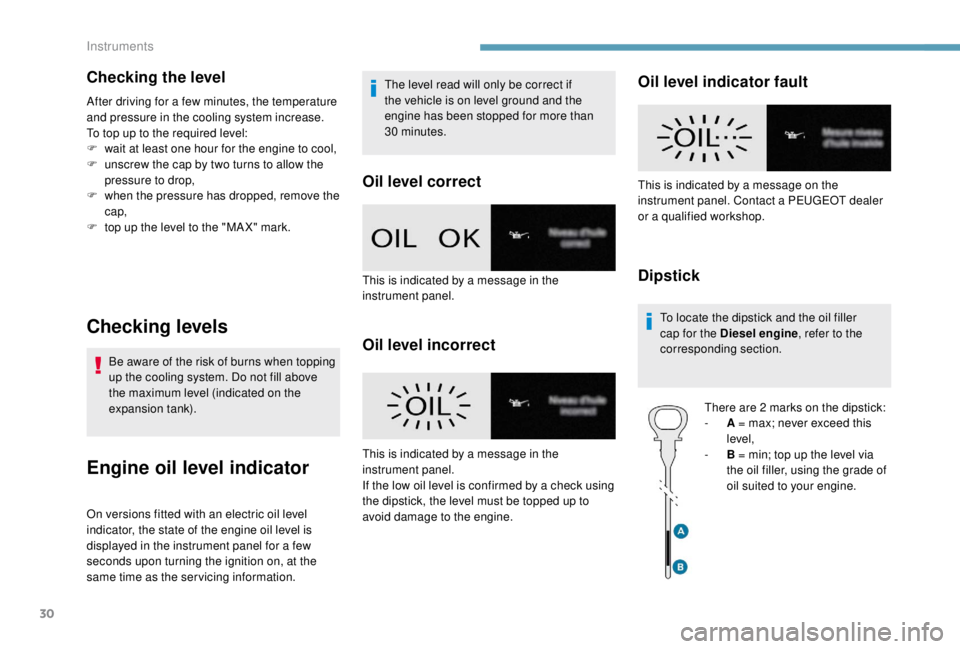
30
Checking the level
After driving for a few minutes, the temperature
and pressure in the cooling system increase.
To top up to the required level:
F
w
ait at least one hour for the engine to cool,
F
u
nscrew the cap by two turns to allow the
pressure to drop,
F
w
hen the pressure has dropped, remove the
cap,
F
t
op up the level to the "MA X" mark.
Checking levels
Be aware of the risk of burns when topping
up the cooling system. Do not fill above
the maximum level (indicated on the
expansion tank).
Engine oil level indicator
On versions fitted with an electric oil level
indicator, the state of the engine oil level is
displayed in the instrument panel for a few
seconds upon turning the ignition on, at the
same time as the ser vicing information. The level read will only be correct if
the vehicle is on level ground and the
engine has been stopped for more than
30
minutes.
Oil level correct
Oil level incorrect
Oil level indicator fault
Dipstick
To locate the dipstick and the oil filler
cap for the Diesel engine
, refer to the
corresponding section.
There are 2
marks on the dipstick:
-
A
= max; never exceed this
level,
-
B
= min; top up the level via
the oil filler, using the grade of
oil suited to your engine.
This is indicated by a message in the
instrument panel.
This is indicated by a message in the
instrument panel.
If the low oil level is confirmed by a check using
the dipstick, the level must be topped up to
avoid damage to the engine. This is indicated by a message on the
instrument panel. Contact a PEUGEOT dealer
or a qualified workshop.
Instruments
Page 249 of 416
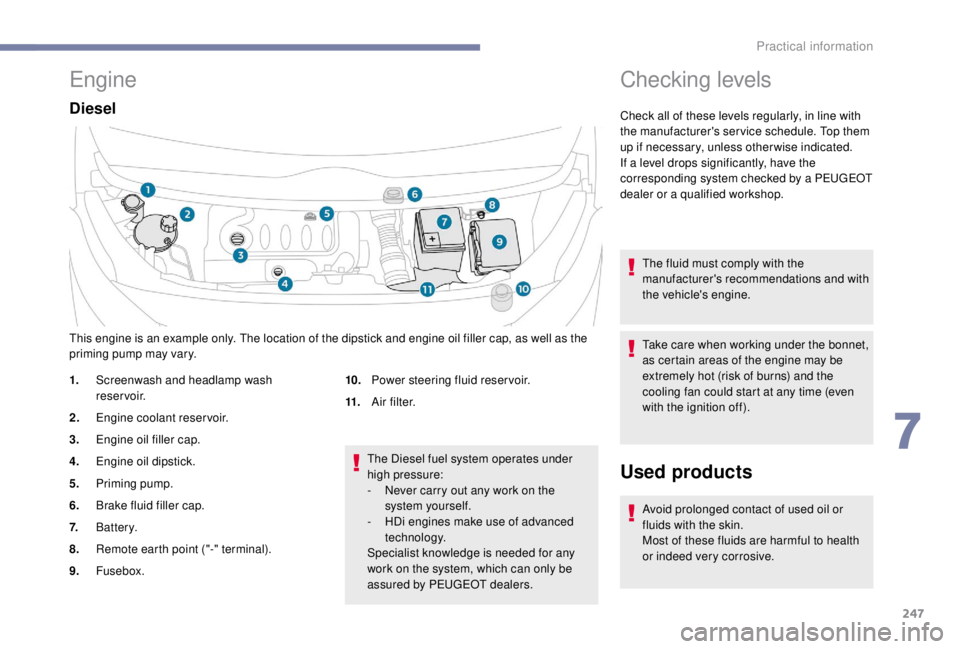
247
Engine
Diesel
The Diesel fuel system operates under
high pressure:
-
N
ever carry out any work on the
system yourself.
-
H
Di engines make use of advanced
technology.
Specialist knowledge is needed for any
work on the system, which can only be
assured by PEUGEOT dealers.
This engine is an example only. The location of the dipstick and engine oil filler cap, as well as the
priming pump may vary.
1.
Screenwash and headlamp wash
reservoir.
2. Engine coolant reservoir.
3. Engine oil filler cap.
4. Engine oil dipstick.
5. Priming pump.
6. Brake fluid filler cap.
7. Battery.
8. Remote earth point ("-" terminal).
9. Fusebox. 10.
Power steering fluid reservoir.
11. A i r f i l t e r.
Checking levels
Check all of these levels regularly, in line with
the manufacturer's service schedule. Top them
up if necessary, unless other wise indicated.
If a level drops significantly, have the
corresponding system checked by a PEUGEOT
dealer or a qualified workshop.
The fluid must comply with the
manufacturer's recommendations and with
the vehicle's engine.
Take care when working under the bonnet,
as certain areas of the engine may be
extremely hot (risk of burns) and the
cooling fan could start at any time (even
with the ignition off).
Used products
Avoid prolonged contact of used oil or
fluids with the skin.
Most of these fluids are harmful to health
or indeed very corrosive.
7
Practical information
Page 250 of 416
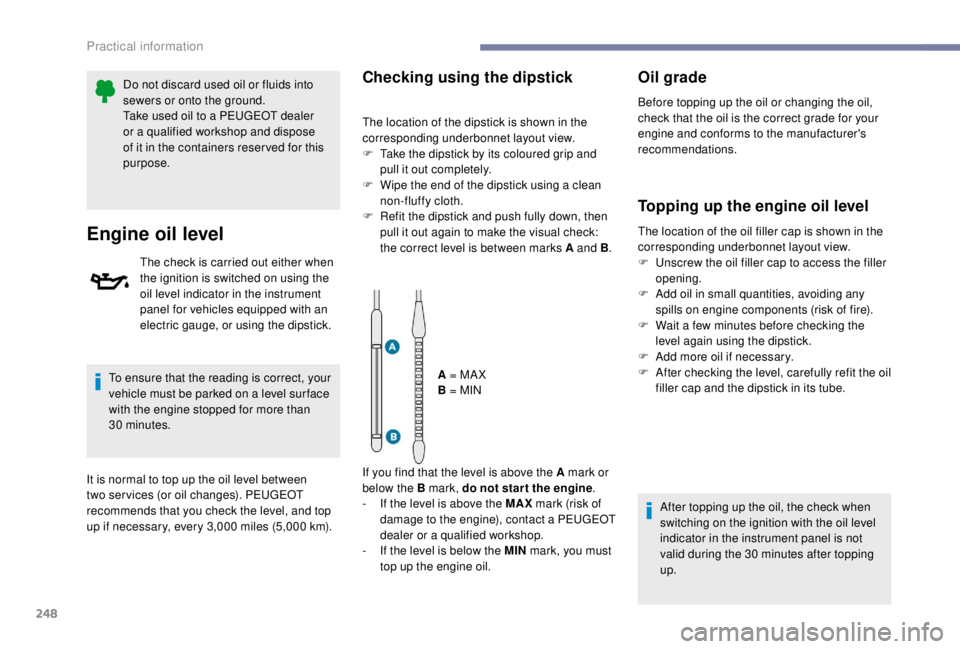
248
Do not discard used oil or fluids into
sewers or onto the ground.
Take used oil to a PEUGEOT dealer
or a qualified workshop and dispose
of it in the containers reser ved for this
purpose.
Engine oil level
The check is carried out either when
the ignition is switched on using the
oil level indicator in the instrument
panel for vehicles equipped with an
electric gauge, or using the dipstick.
To ensure that the reading is correct, your
vehicle must be parked on a level sur face
with the engine stopped for more than
30
minutes.
It is normal to top up the oil level between
two ser vices (or oil changes). PEUGEOT
recommends that you check the level, and top
up if necessary, every 3,000
miles (5,000 km).
Checking using the dipstick
The location of the dipstick is shown in the
corresponding underbonnet layout view.
F
T
ake the dipstick by its coloured grip and
pull it out completely.
F
W
ipe the end of the dipstick using a clean
non-fluffy cloth.
F
R
efit the dipstick and push fully down, then
pull it out again to make the visual check:
the correct level is between marks A and B .
A = MA X
B = MIN
If you find that the level is above the A mark or
below the B mark, do not star t the engine .
-
I
f the level is above the MAX mark (risk of
damage to the engine), contact a PEUGEOT
dealer or a qualified workshop.
-
I
f the level is below the MIN mark, you must
top up the engine oil.
Oil grade
Before topping up the oil or changing the oil,
check that the oil is the correct grade for your
engine and conforms to the manufacturer's
recommendations.
Topping up the engine oil level
The location of the oil filler cap is shown in the
corresponding underbonnet layout view.
F
U
nscrew the oil filler cap to access the filler
opening.
F
A
dd oil in small quantities, avoiding any
spills on engine components (risk of fire).
F
W
ait a few minutes before checking the
level again using the dipstick.
F
A
dd more oil if necessary.
F
A
fter checking the level, carefully refit the oil
filler cap and the dipstick in its tube.
After topping up the oil, the check when
switching on the ignition with the oil level
indicator in the instrument panel is not
valid during the 30
minutes after topping
up.
Practical information
Page 253 of 416
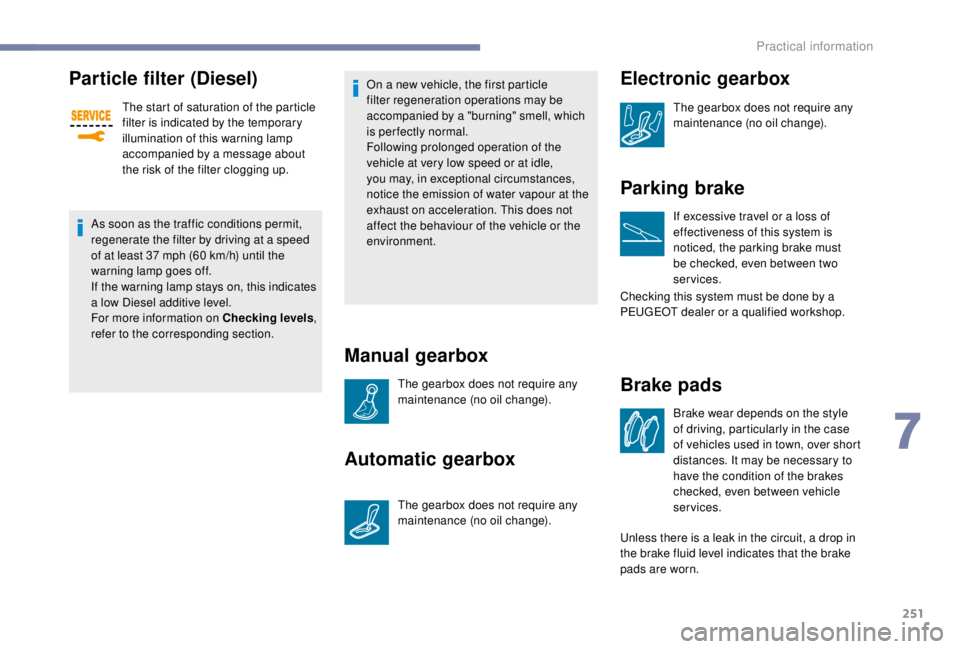
251
Particle filter (Diesel)
The start of saturation of the particle
filter is indicated by the temporary
illumination of this warning lamp
accompanied by a message about
the risk of the filter clogging up.
As soon as the traffic conditions permit,
regenerate the filter by driving at a speed
of at least 37
mph (60 km/h) until the
warning lamp goes off.
If the warning lamp stays on, this indicates
a low Diesel additive level.
For more information on Checking levels ,
refer to the corresponding section. On a new vehicle, the first particle
filter regeneration operations may be
accompanied by a "burning" smell, which
is per fectly normal.
Following prolonged operation of the
vehicle at very low speed or at idle,
you may, in exceptional circumstances,
notice the emission of water vapour at the
exhaust on acceleration. This does not
affect the behaviour of the vehicle or the
environment.
Manual gearbox
The gearbox does not require any
maintenance (no oil change).
Automatic gearbox
The gearbox does not require any
maintenance (no oil change).
Brake pads
Brake wear depends on the style
of driving, particularly in the case
of vehicles used in town, over short
distances. It may be necessary to
have the condition of the brakes
checked, even between vehicle
services.
Unless there is a leak in the circuit, a drop in
the brake fluid level indicates that the brake
pads are worn.
Electronic gearbox
The gearbox does not require any
maintenance (no oil change).
Parking brake
If excessive travel or a loss of
effectiveness of this system is
noticed, the parking brake must
be checked, even between two
services.
Checking this system must be done by a
PEUGEOT dealer or a qualified workshop.
7
Practical information
Page 267 of 416
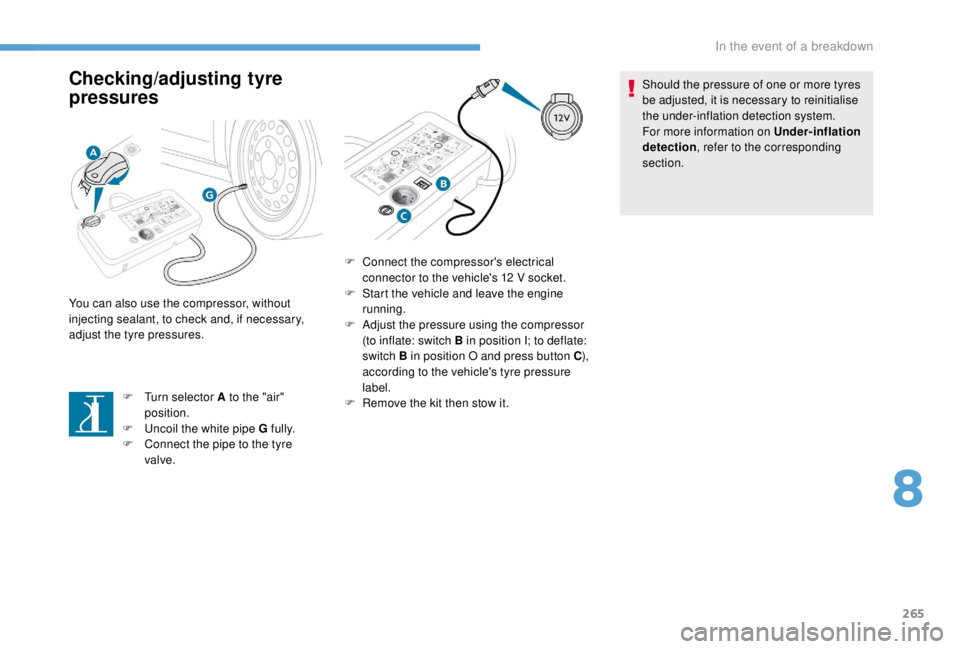
265
Checking/adjusting tyre
pressures
F Turn selector A to the "air" position.
F
U
ncoil the white pipe G fully.
F
C
onnect the pipe to the tyre
valve.
You can also use the compressor, without
injecting sealant, to check and, if necessary,
adjust the tyre pressures.
F
C
onnect the compressor's electrical
connector to the vehicle's 12 V socket.
F
S
tart the vehicle and leave the engine
running.
F
A
djust the pressure using the compressor
(to inflate: switch B in position I; to deflate:
switch B in position O and press button C ),
according to the vehicle's tyre pressure
label.
F R emove the kit then stow it. Should the pressure of one or more tyres
be adjusted, it is necessary to reinitialise
the under-inflation detection system.
For more information on Under-inflation
detection
, refer to the corresponding
section.
8
In the event of a breakdown
Page 405 of 416

307
180° rear vision .....................................23 0-233
Access, AdBlue tank
..................................... 254
Accessories
.......................................... 142, 18 3
Access to the 3rd row
.............................99, 102
Access to the spare wheel
....................267-268
Active Safety Brake......................... 19, 218 -220
AdBlue
® ..................................... 2 2, 31, 252-255
Additive, AdBlue ............................................ 255
Additive, Diesel
..................................... 250-251
Adjusting headlamp beam height
................. 13
7
Adjusting headlamps
.................................... 137
Adjusting head restraints
..........................91, 93
Adjusting seats
.................................... 87, 89 -90
Adjusting the air distribution
...................117-11 8
Adjusting the air flow
............................... 11
7-11 8
Adjusting the date
......................... 37-38, 36, 20
Adjusting the height and reach of the steering wheel
.................................... 85
Adjusting the lumbar support
.......................... 88
A
djusting the seat angle
........................... 88, 90
Adjusting the seat belt height
....................... 1
51
Adjusting the temperature
......................117-11 8
Adjusting the time
......................... 37-38, 36, 20
Advice on driving
................................... 176 -178
Airbags
...............................
.............20, 15 4, 159
Airbags, curtain
...................................... 15 5 -15 6
Airbags, front ................................. 15 4, 15 6, 16 0
Airbags, lateral
....................................... 15 5 -15 6
Air conditioning
...................... 118, 124, 124 -125
Air conditioning, automatic
...........................120
Air conditioning, dual-zone automatic
....117-11 8
Air conditioning, manual ..... 115 -116, 120, 123 -124
Air intake
......................................... 117-11 8 , 12 0
Alarm
......................................................... 81- 83
Alarm, volumetric
............................................ 81
Anti-lock braking system (ABS)
.......19, 145 -14 6
Anti-theft
................................................. 4 4, 185Area, loading
...............................
........
39 - 40, 62
Armrest
................
..........................................
108
Armrest, front ..................................................
91
Anti-slip regulation (ASR)
................
21, 145 -14 6
Assistance call
...............................
........
143 -14 4
Assistance, emergency braking
...
145 -14 6, 2 21
Audio streaming (Bluetooth)
................
27, 11, 10
Auxiliary
..........................................
26-27, 10-11
A
B
C
Battery ............. 15, 242-243, 250, 288, 290 -292
Battery capacity ............................................ 292
Battery, charging
................................... 289-290
Battery, remote control
.........45 - 46, 59 - 60, 127
Bench seat, one-piece, fixed
................... 9
9 -101
Blind spot monitoring system
................225-226
Blind spot sensors
.......................................... 25
BlueHDi
............................................. 23, 31, 252
Bluetooth (hands-free)
........ 2
8 -2 9, 15 -16 , 11-12
Bluetooth (telephone)
..................... 2
8 - 3 0, 15 -17
Bonnet
........................................................... 246
Boot
................................................................. 80
Brake discs
............................................. 251-252
Brake lamps
...............................
...........278-282
Brakes
........................................ 14, 19, 251-252
Braking, automatic emergency
........19, 218 -221
Brightness
....................................................... 19
Bulbs (changing)
...................272-273, 278, 280
Bulbs (changing, type)
..........................272-273
Cable, audio
.............................................. 26, 10
Cable, jack
................................................ 26, 10
Capacity, fuel tank
................................. 237-238Cap, fuel filler
...............................
..........
237-238
CarPlay connection ................................... 18, 13
CD
....................................................
26 -27, 11, 9
CD, MP3
......................................
26 -27, 11, 9 -10
Central locking
.................................... 50
, 54-55
Changing a bulb
..................... 2
72-273, 278-282
Changing a bulb (tailgate)
.............................
280
Changing a bulb (side-hinged doors)
........... 2
78
Changing a fuse
.................................... 28
3-287
Changing a wheel
......................................... 26
6
Changing a wiper blade
........................ 1
41, 2 4 5
Changing the remote control battery
.........................................
45 - 46, 59 - 60
Checking the engine oil level ..........................
30
Checking the levels ...............................247, 249
Checking tyre pressures (using the kit)
......................................260-265
Checks
...........................................247, 250-252
Checks, routine
.....................................250-252
Child lock
................................................174 -175
Child lock, electric
.........................................174
Child lock on rear windows
...........................175
Children
..................................16 4, 16 8 -170, 172
Children (safety)
............................................174
Child seats
.............15
3, 157-159, 163 -16 6, 173
Child seats, conventional
......................163 -166
Child seats, ISOFIX
.......................16 8 -170, 172
Closing the boot
..............................................80
Closing the doors
...................50, 54-55, 63 - 66,
69 -70, 77-79
Collision risk alert
............19, 218 -219, 218 -220
Compressor, tyre inflation
............................260
Connection, Bluetooth
...21-22, 28 -30, 15 -17, 12
Connection, MirrorLink
........................19, 12-14
Connection, Wi-Fi network
.............................22
Control, emergency boot release
...................80
Control, emergency door
............... 4
4 - 4 5 , 57- 5 9
Control, heated seats
................................91-92
Control stalk, lighting
..............................26, 13 0
Control stalk, wipers
..............................13
7-13 9
Courtesy lamp
...............................................279
.
Alphabetical index